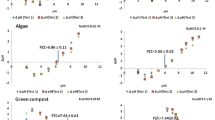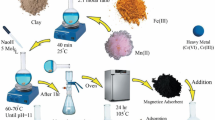Abstract
Li-, Na-, K- and Ca-saturated Wyoming montmorillonites have been prepared and used to obtain Li.Na-, Li,K-, and Li,Ca-montmorillonites with a range of Li contents. These were heated at 220°C for 24 hr, causing the Li+ ions to migrate mainly into the layer structure and leaving varying amounts of Li+, Na+, K+, and Ca2+ ions in the interlayer positions as determined by exchange with NH4+ ions. The results are only partially consistent with a migration of the Li+ ions into vacant octahedral sites up to the limit of the octahedral layer charge. Solvation of the resulting clays with water and various organic liquids showed the following results: With water, acetone and 3-pentanone, expansion of the montmorillonites increased in a step-wise manner with increasing numbers of interlayer cations qualitatively in accord with the field strength of the cations and the dipole moments of the molecules. With ethanol, ethylene glycol and morpholine, swelling with each liquid was practically independent of the number of interlayer cations, within the limits of the prepared materials. It is suggested that for the second group of liquids some mechanism additional to cation-dipole interactions, such as hydrogen bonding to silicate oxygen surfaces, may play an important part.
Résumé
Des échantillons de montmorillonite du Wyoming saturés par Li, Na, K et Ca ont été préparés et utilisés pour obtenir des montmorillonites Li-Na, Li-K, Li-Ca, à différentes teneurs en Li. Ces argiles ont été chauffées à 220°C pendant 24 heures, ce qui entraîne une migration des ions Li+ principalement à l’intérieur du réseau et ce qui laisse en position interfeuillet des quantités variables d’ions Li+, Na+, K+ et Ca2+ qui sont dosés par échange avec l’ion NH4+. Les résultats ne sont seulement que partiellement compatibles avec une migration des ions Li+ dans les sites octaédriques vacants, dans la limite de la charge de la couche octaédrique. La solvatation des argiles résultantes, avec l’eau et divers liquides organiques, donne les résultats suivants: avec l’eau, l’acétone et la 3-pentanone, l’ouverture des montmorillonites progresse par paliers quand le nombre de cations interlamellaires augmente, en accord qualitatif avec l’intensité du champ des cations et les moments dipolaires des molécules. Avec l’éthanol, l’éthylène glycol et la morpholine, le gonflement est pratiquement indépendant du nombre de cations interlamellaires, à l’intérieur des limites correspondant aux matériaux préparés. Il est suggéré que pour le second groupe de liquides, un mécanisme qui s’ajoute aux interactions cation-dipole, comme une liaison hydrogène avec les atomes d’oxygène de la surface du silicate, puisse jouer un rôle important.
Kurzreferat
Li-, Na-, K- und Ca-gesättigte Wyoming Montmorillonite wurden bereitet und dazu verwendet Li, Na-, Li, K-, und Li,Ca-Montmorillonite mit einem Bereich von Li-Gehalten zu erhalten. Diese wurden für 24 Stunden auf 220°C erhitzt wobei die Li+ Ionen hauptsächlich in das Schichtgefüge wanderten und verschiedene Mengen an Li+, Na+, K+, und Ca2+ in den Zwischenschichtpositionen zurückblieben, was durch Austausch mit NH4+ Ionen nachgewiesen wurde. Die Ergebnisse sind nur teilweise mit einer Wanderung der Li+ Ionen in die oktaedrischen Leerstellen bis zur Grenze der oktaedrischen Schichtladung vereinbar. Solvation der sich ergebenden Tone mit Wasser und verschiedenen organischen Flüssigkeiten führte zu folgenden Resultaten: Mit Wasser, Aceton und 3-Pentanon nahm die Expansion der Montmorillonite mit wachsender Zahl der Zwischenschichtkationen qualitative im Einklang mit der Feldstärke der Kationen und den Dipolmomenten der Moleküle zu. Bei Äthanol, Äthylenglykol und Morpholin war die Quellung mit der jeweiligen Flüssigkeit praktisch unabhängig von der Zahl der Zwischenschichtkationen, innerhalb der Grenzen der hergestellten Stoffe. Es wird die Vermutung ausgesprochen, dass bei der zweiten Gruppe von Flüssigkeiten ein Mechanismus zusätzlich zu den Kation-Dipolwechselwirkungen, wie etwa Wasserstoffbindung an Silikatsauerstoffoberflächen, eine wichtige Rolle spielen könnte.
Резюме
Специально приготовленные насыщенные Li-, Na-, K-, и Са-монтмориллониты Вайоминга использовались для получения Li, Na-, Li, K-и Li, Са-монтмориллонитов с различным содержанием Li. Эти монтмориллониты нагревались при температуре 220°С в течение 24 часов, в результате чего ионы Li+ мигрировали, главным образом, вглубь слоистой структуры; некоторые количества ионов Li+, Na+, K+ и Са2+ оставались в межслоевых положениях, что определялось по обмену с ионами NH4+. Полученные результаты лишь частично согласуются с представлением о миграции ионов Li+ в вакантные октаэдрические положения до достижения предельного заряда октаэдрической сетки. Обработка полученных глин водой и различными органическими жидкостями привела к следующим результатам: при обработке водой, ацетоном и 3-пентаноном разбухание монтмориллонита возрастало ступенчато, что сопровождалось возрастанием числа межслоевых катионов, в приближенном соответствии с силовым полем катионов и дипольным моментом молекул. При обработке этанолом, этилен-гликолем и морфолином разбухание в каждой жидкости практически не зависело от числа межслоевых катионов в препаратах. Предполагается, что для второй группы жидкостей важную роль может играть какой-либо дополнительный механизм к катиондипольному взаимодействию, например, водородные связи с кислородными поверхностями силикатных слоев.
Similar content being viewed by others
References
Bissada, K. K., Johns, W. D. and Cheng, F. S. (1967) Cation-dipole interactions in clay organic complexes: Clay Minerals 7, 155–166.
Brindley, G. W. and Ray, S. (1964) Complexes of Camontmorillonite with primary monohydric alcohols: Am. Mineralogist 49, 106–115.
Calvet, R. and Prost, R. (1971) Cation migration into empty octahedral sites and surface properties of clays: Clay and Clay Minerals 19, 175–186.
Dowdy, R. H. and M. M. Mortland (1967) Alcohol-water interactions on montmorillonite surfaces—I. Ethanol: Clays and Clay Minerals 15, 259–271.
Emerson, W. W. (1957) Organo-clay complexes: Nature 180, 48–49.
Fanner, V. C. and Russell, J. D. (1967) I.R. absorption spectrometry in clay studies: Clays and Clay Minerals 15, 121–142.
Glaeser, R. and Mering, J. (1967) Effet de chauffage sur les montmorillonites saturées de cations de petit rayon: C. R. hebd. SéancAcad. Sci. Paris 265D, 833–835.
Greene-Kelly, R. (1953) Irreversible dehydration in montmorillonite—II: Clay Min. Bull. 2, 52–56.
Greene-Kelly, R. (1955) Dehydration of the montmorillonite minerals: Mineral. Mag. 30, 604–615.
Hofmann, U. and Kiemen, R. (1950) Verlust der Austauschfähigkeit von Lithiumionen an Bentonit durch Erhitzung: Z. Anorg. Allg. Chem. 262, 95–99.
Mering, J. and Glaeser, R. (1967) Réarrangement structural de la montmorillonite-Li sous l’effet de chauffage: C. r. hebd.Séanc. Acad. Sci. Paris 265D, 1153–1156.
Prost, R. and Calvet, R. (1969) Position du lithium dans une montmorillonite Li chauffé: C. r. hebd. Séanc. Acad. Sci. Paris 269D, 539–541.
Quirk, J. P. and Theng, B. K. G. (1960) Effect of surface density of charge on the physical swelling of Limontmorillonite: Nature 187, 967–968.
Russell, J. D. and Farmer, V. C. (1964) I.R. spectroscopic study of the dehydration of montmorillonite and saponite: Clay Min. Bull. 5, 443–464.
Schultz, L. G. (1969) Lithium and potassium absorption, dehydroxylation temperature, and structural water content of aluminous smectites: Clays and Clay Minerals 17, 115–149.
Tettenhorst, R. (1962) Cation migration in montmorillonites: Am. Mineralogist 47, 769–773.
Author information
Authors and Affiliations
Rights and permissions
About this article
Cite this article
Brindley, G.W., Ertem, G. Preparation and Solvation Properties of Some Variable Charge Montmorillonites. Clays Clay Miner. 19, 399–404 (1971). https://doi.org/10.1346/CCMN.1971.0190608
Received:
Published:
Issue Date:
DOI: https://doi.org/10.1346/CCMN.1971.0190608




